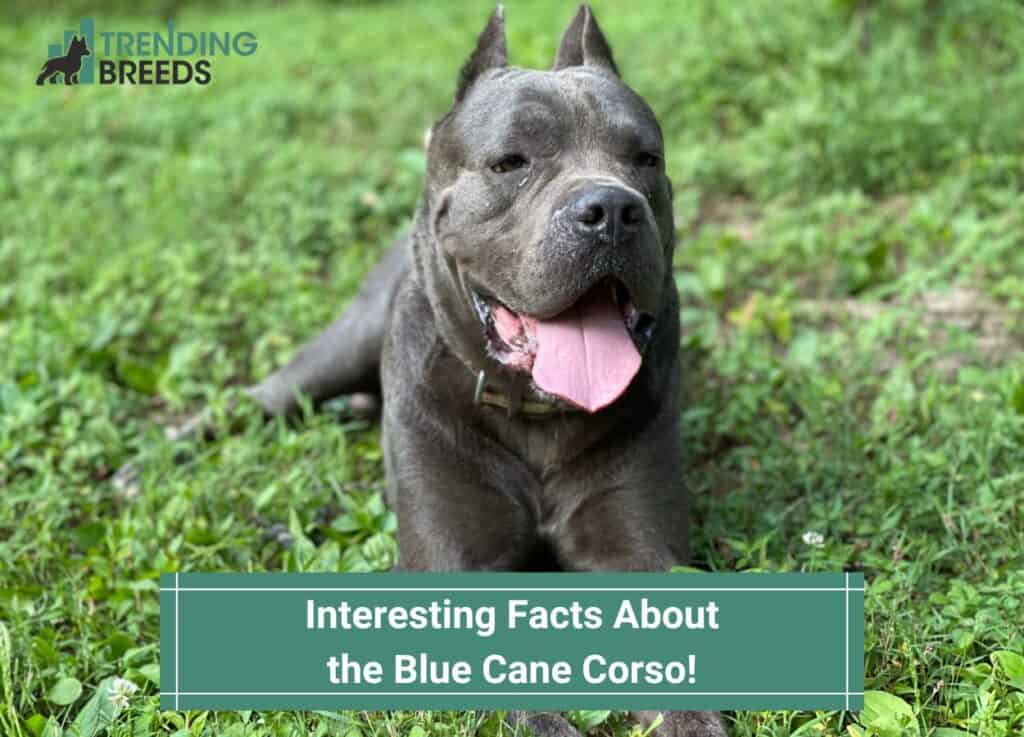
The Cane Corso is often considered one of the most majestic breeds of dogs.
With the classic, formidable look of a mastiff, those who don’t know may see this dog as scary. However, a Cane Corso is one of the sweetest, most fierce companions any dog lover can have.
The blue Cane Corso is one of the color variations of the breed available. These dogs’ silky, gray coats are beautiful, and the dog’s instinct to protect others makes it an excellent guard dog for families.
Read on to find out thirteen interesting facts about the Blue Cane Corso.
Other articles you would like: Are Cane Corsos Naturally Protective? and Cane Corso Puppy Costs
Table of Contents
Interesting Facts About the Blue Cane Corso
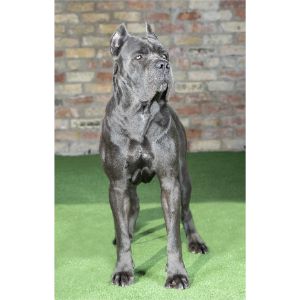
Here are thirteen fascinating facts about the beautiful Blue Cane Corso breed.
1. Large and in Charge
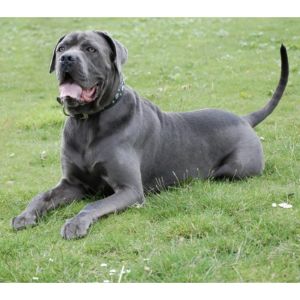
Calling the Cane Corso a “big dog” would be an understatement. This breed is among the largest dog breeds in the world.
Male Cane Corsos measure between 25 and 27.5 inches tall, and female Cane Corsos measure between 23.5 and 26 inches.
For both males and females within the breed, weight is dependent on height and is roughly proportional. Because of this, it’s common for Cane Corsos to weigh more than 100 pounds.
In addition, the Blue Cane Corso has a slightly longer lifespan than other breeds in the “largest dog” category. Life expectancy for the Cane Corso breed lands between nine and twelve years.
In comparison, the Mastiff breed, a close relative of the Cane Corso, has a life expectancy between six and ten years.
2. Originated in Italy
The modern Cane Corso breed can trace its roots back to Italy. Though ancestors of the dog existed in Ancient Rome and Greece, the present-day breed was primarily formed in Italy.
As the popularity of the Cane Corso grew in early civilization, the dogs were exported to Italy.
In Italy, the Cane Corso became an incredibly popular dog within the peninsula, especially among farmers and ranchers.
The dog was great at herding cattle but also served as an excellent guard dog for farmers who feared their homestead might be robbed at night.
It is from these Italian Cane Corsos that the modern breed was cultivated.
3. (Almost) A Rare Breed
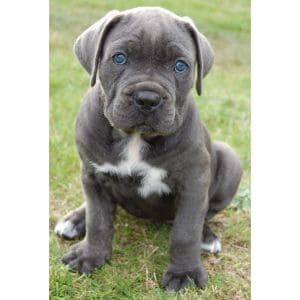
In the 1960s, the Cane Corso breed almost went extinct. At this time, the dogs could only be found in Puglia, a region in southern Italy. For decades, Cane Corsos served as faithful farm dogs who herded cattle and helped keep away predators.
The widespread sharecropping system dissolved in Italy during the 1960s, and the need for herding dogs dropped significantly. The Cane Corso population slowly dwindled to mere dozens of dogs left.
In 1980, a movement to preserve the Cane Corso breed began taking hold among breeders in Italy.
In 1983, the Cane Corso breed society officially formed and cemented the breed’s status as a protected breed with particular breeding implemented to increase the population.
4. Descended From Ancient Roman War Dogs
The Cane Corso breed has a robust history, with texts, paintings, and stories featuring the breed in Ancient Rome. Many people believe the Cane Corso breed and others in the Mastiff family descended from the Molossus, an ancient now-extinct dog breed.
In Ancient Rome, these massive dogs stood along the war front and would assist soldiers in rushing the enemy. When not on the front lines, these dogs served as guardian dogs at homes, bases, and farms.
After the fall of the Roman empire, the role of these dogs changed from war dogs to companions and working dogs.
5. One of Seven Distinct Colorings

The blue variation is just one of seven distinct colors that a Cane Corso’s coat may be. The other six coat colors are black, fawn, red, black brindle, and chestnut brindle.
The fawn coat is the most prevalent in Cane Corso puppies. “Fawn” is a coat variation that ranges from a very light tan or cream color to a slightly dusty brown. A red coat is a brown color with a reddish tint.
“Brindle” is not a color but a pattern that counts as a separate coat color variation. It’s often compared to tiger stripes, though the color difference is subtler. For Cane Corsos, brindle patterns may come in black, chestnut, or gray (referred to as blue).
6. Better Together
If you’ve ever wanted a dog that will follow you wherever you go, the Cane Corso is an excellent option. These dogs are incredibly loving once they are a part of the family, and they would usually rather spend time with you than alone.
Whether your Cane Corso is in a family, just with you, or surrounded by other animals, they will be fiercely loyal to you and anyone else they consider to be in their pack. When you have a Cane Corso, you should expect to spend tons of time with this dog.
7. Bite Worse Than Its Bark
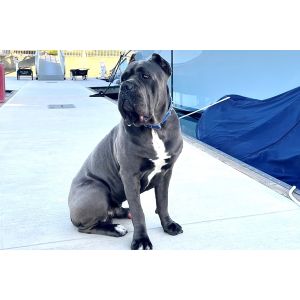
The Cane Corso is not an aggressive breed, but they have an incredibly impressive bite force.
Cane Corsos have an average bite force of 525 PSI (pounds per square inch), and measurements as high as 700 PSI have been measured in some dogs. In comparison, humans have an average bite force of 140 PSI.
Considering the average Cane Corso weighs around 100 pounds, this is a very high bite force for its size. Only two breeds have a higher bite force than the Cane Corso. The Kangal has a bite force of 743 PSI, and the American Bandogge measures 730 PSI.
Cane Corsos are generally very peaceful dogs, but they are considered fierce guard dogs and protectors of their families. With such a high bite force, this breed is undoubtedly considered one of the most formidable guard dogs.
8. A Dog With a Job
The Cane Corso breed is a part of the “Working Group” in the American Kennel Club’s classification. The Working Group category is filled with large dogs that have assisted humans with several jobs throughout history.
The Cane Corso is recognized as a guard dog, herding dog, and hunting dog as the jobs it was bred for and has been effective at.
Other breeds in this category with a history of work are the Alaskan Malamute (sled dog), Greater Swiss Mountain Dog (pasture dog), and Saint Bernard (nanny dog).
Although most Cane Corsos are pure companion dogs now, these dogs will still attempt to fulfill their ingrained duties. For families, you may find your dog attempting to herd you, your children, or other pets to be helpful.
9. Vocal Pup
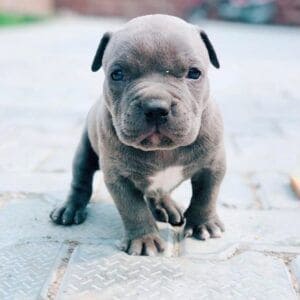
Cane Corsos are a very vocal breed, though they aren’t frequent barkers like a Chihuahua. Instead, these dogs make various noises and vocalizations that the American Kennel Club classifies as howling, singing, snorting, and snuffling.
These dogs don’t howl as frequently as other breeds like the Siberian Husky, but they will occasionally tilt their heads up and howl for seemingly no reason.
Most of the time, dogs howl because they feel like it. It’s a cathartic release in the same way yelling is for humans.
More frequently, Cane Corso owners will find their pups “singing.” It may sound odd, but many dogs will emit sounds similar to a howl but quieter and follow a bit of a beat.
Dogs sometimes attempt to sing along to songs or noises they hear, which can be incredibly fun to watch.
10. An Excellent Hunter
Cane Corso dogs are excellent hunters, both as hunter-helpers and hunters. The dog’s large size, muscular body, fast speed, and powerful bite all come together to make it easy for this dog to take down prey.
In the distant past, Cane Corsos were used frequently to hunt wild game in the forests of Italy, Rome, and Greece. These dogs were often brought as companions to wealthy families as they hunted.
Rather than simply pointing and tracking, these dogs actively hunted prey themselves and often took down birds, deer, and wild boar.
11. A Guardian Dog
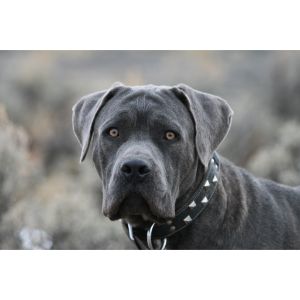
The most well-known aspect of the Cane Corso breed is their protective nature and ability as a guard dog. These dogs are highly loyal and will defend their family at any turn.
As a large dog with a strong bite, the Cane Corso breed has become the most effective guard dog throughout history for many families.
The name “Cane Corso” translates to “Guardian Dog,” so this dog has been recognized as a fierce protector throughout its known history.
The translation comes from Italian, the breed’s origin, and references the dog’s role as protector of the family and protector of the farm where the dogs often worked.
12. Blue Means Gray
Regarding the world of dogs and their coat colors, “blue” means gray. Don’t expect a powder blue puppy to show up when you’re looking at these dogs.
The name likely comes from the tone of the color rather than the actual color present. This reasoning is the same in a “red” coat for dogs, which is brown but with a reddish tint.
The American Kennel Club sets the standards for the breed, and interestingly, for the Cane Corso, blue eyes are considered a fault and are not accepted within the breed standard.
Pictures of Cane Corso puppies often highlight the breed’s bright, blue eyes, but the eyes generally change color as the dog grows up.
The accepted eye colors within the breed standard are brown, amber, and gold.
13. Blue Due to Recessive Genes

Blue fur coats for Cane Corsos come from a recessive gene rather than a dominant one, like the gene for a black coat. A recessive gene is a gene that will not present unless both parents carry the gene.
If a dog’s genetic makeup is created and one parent has a recessive blue coat gene and the other parent has a dominant black coat gene, the black coat gene will dominate.
Because of this, the blue coat was generally considered the rarest in the Cane Corso breed.
However, due to decades of practice in the genetic breeding of dogs, it is no longer considered rare as the blue gene can be isolated and guarantee the puppy will carry the gene.
Many people still consider a blue brindle Cane Corso to be rare due to the family of breeds it belongs to. Among all the dogs descended from the Molossus breed, the Cane Corso is the only breed with a blue coat color within its standard.
Conclusion For “Interesting Facts About the Blue Cane Corso!”
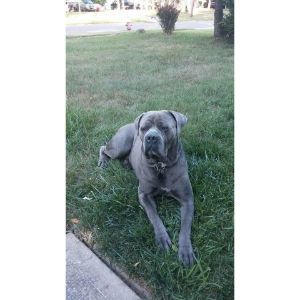
The Blue Cane Corso breed may seem a bit mysterious initially, but these lovable pups have a long, storied history to back up the breed. From Ancient Rome to Greece, these dogs have been great companions for centuries.
Were you shocked to find out the history behind this majestic breed?
You will also like:
- Cane Corso Rottweiler Mix
- Are Cane Corsos Hypoallergenic?
- Interesting Facts About The Brindle Cane Corso
For more information about the Cane Corso Breed, check out the video below:




